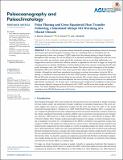Polar phasing and cross‐equatorial heat transfer following a simulated abrupt NH warming of a glacial climate
Author(s)
Moreno Chamarro, Eduardo; Ferreira, D; Marshall, John
DownloadPublished version (2.834Mb)
Publisher Policy
Publisher Policy
Article is made available in accordance with the publisher's policy and may be subject to US copyright law. Please refer to the publisher's site for terms of use.
Terms of use
Metadata
Show full item recordAbstract
© 2020. American Geophysical Union. All Rights Reserved. A 150- to 220-year lag between abrupt Greenland warming and maximum Antarctic warming characterizes past glacial Dansgaard-Oeschger events. In a modeling study, we investigate how the cross-equatorial oceanic heat transport (COHT) might drive this phasing during an abrupt Northern Hemisphere (NH) warming. We use the MITgcm in an idealized continental configuration with two ocean basins, one wider, one narrower, under glacial-like conditions with sea ice reaching midlatitudes. An exaggerated eccentricity-related solar radiation anomaly is imposed over 100 years to trigger an abrupt NH warming and sea-ice melting. The Hadley circulation shifts northward in response, weakening the NH trade winds, subtropical cells, and COHT in both ocean basins. This induces heat convergence in the Southern Hemisphere (SH) ocean subsurface, from where upward heat release melts sea ice and warms SH high latitudes. Although the small-basin meridional overturning circulation also weakens, driven by NH ice melting, it contributes at most one-third to the total COHT anomaly, hence playing a subsidiary role in the SH and NH initial warming. Switching off the forcing cools the NH; yet heat release continues from the SH ocean subsurface via isopycnal advection-diffusion and vertical mixing, driving further sea ice melting and high latitude warming for ~50–70 more years. A phasing in polar temperatures resembling reconstructions thus emerges, linked to changes in the subtropical cells’ COHT, and SH ocean heat storage and surface fluxes. Our results highlight the potential role of the atmosphere circulation and wind-driven global ocean circulation in the NH–SH phasing seen in DO events.
Date issued
2020Department
Massachusetts Institute of Technology. Department of Earth, Atmospheric, and Planetary SciencesJournal
Paleoceanography and Paleoclimatology
Publisher
American Geophysical Union (AGU)